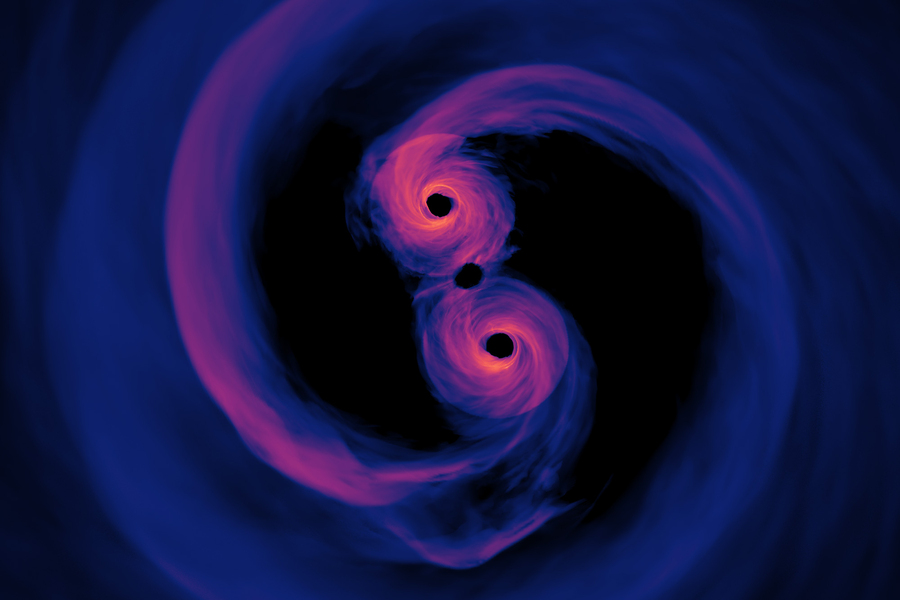(Massachusetts Institute of Technology) Clues to a black hole’s origins can be found in the way it spins. This is especially true for binaries, in which two black holes circle close together before merging. The spin and tilt of the respective black holes just before they merge can reveal whether the invisible giants arose from a quiet galactic disk or a more dynamic cluster of stars.
Astronomers are hoping to tease out which of these origin stories is more likely by analyzing the 69 confirmed binaries detected to date. But a new study finds that for now, the current catalog of binaries is not enough to reveal anything fundamental about how black holes form.
In a study appearing today in the journal Astronomy and Astrophysics Letters, MIT physicists show that when all the known binaries and their spins are worked into models of black hole formation, the conclusions can look very different, depending on the particular model used to interpret the data.
A black hole’s origins can therefore be “spun” in different ways, depending on a model’s assumptions of how the universe works.
“When you change the model and make it more flexible or make different assumptions, you get a different answer about how black holes formed in the universe,” says study co-author Sylvia Biscoveanu, an MIT graduate student working in the LIGO Laboratory. “We show that people need to be careful because we are not yet at the stage with our data where we can believe what the model tells us.”
The study’s co-authors include Colm Talbot, an MIT postdoc, and Salvatore Vitale, an associate professor of physics and a member of the Kavli Institute of Astrophysics and Space Research at MIT.
Black holes in binary systems are thought to arise via one of two paths. The first is through “field binary evolution,” in which two stars evolve together and eventually explode in supernovae, leaving behind two black holes that continue circling in a binary system. In this scenario, the black holes should have relatively aligned spins, as they would have had time — first as stars, then black holes — to pull and tug each other into similar orientations. If a binary’s black holes have roughly the same spin, scientists believe they must have evolved in a relatively quiet environment, such as a galactic disk.
Black hole binaries can also form through “dynamical assembly,” where two black holes evolve separately, each with a distinct tilt and spin. By some extreme astrophysical processes, the black holes are eventually brought together, close enough to form a binary system. Such a dynamical pairing would likely occur not in a quiet galactic disk, but in a more dense environment, such as a globular cluster, where the interaction of thousands of stars can knock two black holes together. If a binary’s black holes have randomly oriented spins, they likely formed in a globular cluster.
But what fraction of binaries form through one channel versus the other? The answer, astronomers believe, should lie in data, and particularly, measurements of black hole spins.
To date, astronomers have derived the spins of black holes in 69 binaries, which have been discovered by a network of gravitational-wave detectors including LIGO in the U.S., and Italian counterpart Virgo. Each detector listens for signs of gravitational waves — very subtle reverberations through space-time that are left over from extreme, astrophysical events such as the merging of massive black holes.
With each binary detection, astronomers have estimated the respective black hole’s properties, including their mass and spin. They have worked the spin measurements into a generally accepted model of black hole formation, and found signs that binaries could have both a preferred, aligned spin, as well as random spins. That is, the universe could produce binaries in both galactic disks and globular clusters.
“But we wanted to know, do we have enough data to make this distinction?” Biscoveanu says. “And it turns out, things are messy and uncertain, and it’s harder than it looks.”


